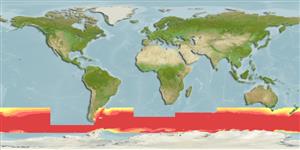Teleostei (teleosts) >
Myctophiformes (Lanternfishes) >
Myctophidae (Lanternfishes) > Myctophinae
Etymology: Electrona: Greek, elektron = amber (Ref. 45335).
Environment: milieu / climate zone / depth range / distribution range
Ecology
Marine; bathypelagic; oceanodromous (Ref. 5182); depth range 1 - 1008 m (Ref. 114491), usually 100 - 350 m (Ref. 4066). Deep-water; 39°S - 69°S, 180°W - 180°E (Ref. 5182)
Circumglobal between the Subtropical Convergence and Antarctic Polar Front.
Length at first maturity / Size / Weight / Age
Maturity: Lm 8.3 range ? - ? cm
Max length : 11.2 cm SL male/unsexed; (Ref. 114491); 9.6 cm SL (female); max. published weight: 12.10 g (Ref. 5182); max. published weight: 12.10 g; max. reported age: 6 years (Ref. 31516)
Oceanic and mesopelagic, found in the upper 100 m south of 50°S, but below 550 m in the region of Subtropical Convergence (Ref. 4066). Migrates from 80 to 140 m to the surface at about 18h00 with ascent rate of 0.5 m per minute; the descent rate is 1.8 m per minute. Forms the main component of the Deep Scattering Layer in the Pacific sector. Feeds on copepods, hyperiids and euphausiids, but also takes ostracods and gastropods. Eaten by squid and to an insignificant degree, by fishes (Channichthyidae, Notolepis sp.) and birds (Procellariidae).
Life cycle and mating behavior
Maturities | Reproduction | Spawnings | Egg(s) | Fecundities | Larvae
Hulley, P.A., 1990. Myctophidae. p. 146-178. In O. Gon and P.C. Heemstra (eds.) Fishes of the Southern Ocean. J.L.B. Smith Institute of Ichthyology, Grahamstown, South Africa. (Ref. 5182)
IUCN Red List Status (Ref. 130435)
Threat to humans
Harmless
Human uses
Fisheries: commercial
Tools
Special reports
Download XML
Internet sources
Estimates based on models
Preferred temperature (Ref.
123201): -1.3 - 2.4, mean 0.7 °C (based on 31 cells).
Phylogenetic diversity index (Ref.
82804): PD
50 = 0.5312 [Uniqueness, from 0.5 = low to 2.0 = high].
Bayesian length-weight: a=0.00692 (0.00297 - 0.01609), b=3.13 (2.93 - 3.33), in cm total length, based on LWR estimates for this (Sub)family-body shape (Ref.
93245).
Trophic level (Ref.
69278): 3.2 ±0.0 se; based on diet studies.
Generation time: 2.0 ( na - na) years. Estimated as median ln(3)/K based on 1
growth studies.
Resilience (Ref.
120179): Medium, minimum population doubling time 1.4 - 4.4 years (K=0.55; tmax=5.5).
Fishing Vulnerability (Ref.
59153): Low vulnerability (24 of 100).
Nutrients (Ref.
124155): Calcium = 101 [28, 274] mg/100g; Iron = 0.564 [0.211, 1.748] mg/100g; Protein = 15.9 [14.2, 17.7] %; Omega3 = 0.312 [0.105, 0.898] g/100g; Selenium = 14.1 [4.4, 45.1] μg/100g; VitaminA = 70.5 [8.4, 565.3] μg/100g; Zinc = 0.808 [0.411, 1.717] mg/100g (wet weight); based on
nutrient studies.
